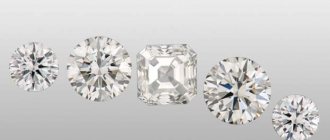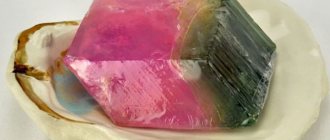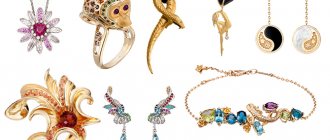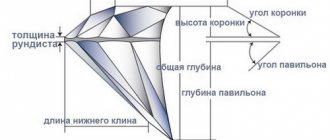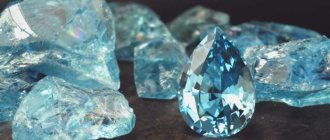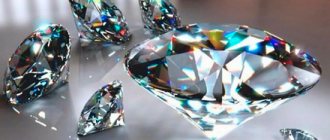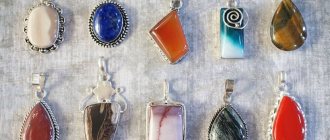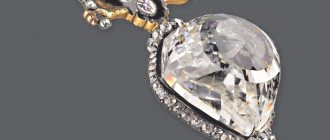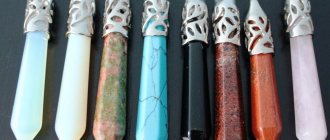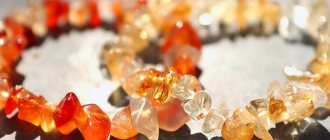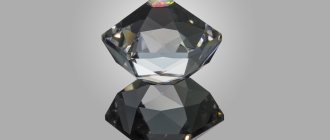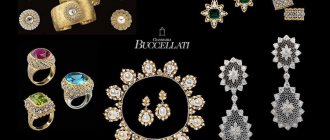When choosing jewelry with emeralds, rubies or other precious stones, you can almost always find the “GT” mark in the description. It means that the pebble insert is hydrothermal. But what is a hydrothermal gemstone, accessories, jewelry or jewelry?
The origin of the mineral is interesting, its reputation is impeccable.
Background
They tried to grow precious minerals two hundred years ago. The object of attention was ruby and emerald as the rarest, most beautiful and expensive.
The first hydrothermal emeralds of jewelry grade were obtained by the American Emily Flanigan at the dawn of the 1960s. However, the process died out before it was completed, and the crystals had to be transplanted into another “box” for growth.
Ten years later, Soviet scientists solved this problem. They achieved permanent, non-transplantation growth of emerald crystals from hydrothermal solutions. Today in Russia a technology has been developed that is also used to create other precious and semi-precious stones.
Hydrothermal gems
Production technology
From the term “hydrothermal” it is clear that we are talking about water plus high temperature.
The technology for producing hydrothermal stones consists of crystallizing the substance from a hot aqueous solution at 650–700 °C and a pressure of 1500 atmospheres (1.5 Kbar).
Equipment
Hydrothermal stones are grown in an autoclave - a special vessel made of high-strength, corrosion-resistant steel. It is also called the growth chamber:
- A diaphragm - a hardened perforated plate - is fixed in the center. It serves as a separator between the “cold” and “hot” zones. This is the raw material dissolution zone (lower, under the separator) and the crystal growth zone (upper, above the separator).
- Seed plates are installed in the upper segment. They are carved from the natural stone they want to obtain. Crystals will grow on them.
Installation for growing from hydrothermal stones
Before the start of each cycle, the walls of the container are tested for defects: the slightest deviation causes an explosion.
Stages
The hydrothermal process includes the following steps:
- The raw material mixture is placed at the bottom - a substance that will dissolve. They are crushed precious or semi-precious minerals of non-jewelry grade. To create an emerald it is beryl.
- Then a mineralizer is added - the salt component of the aqueous solution. This is a mixture that increases the solubility of raw materials with a hydrothermal solution. Consists of the same elements as natural stone. Thus, vanadium and chromium are additives for emerald.
- The loaded autoclave is tightly closed at the top and fed into the oven. Heats up to 650–700 °C, experiencing a pressure of 1500 atmospheres (1.5 Kbar).
- The lower part gets hotter. The solution is saturated with the components of the charge, and thermal convection delivers its vapor to the growth zone.
- Here they cool, becoming supersaturated. Excess substance accumulates on the seed plates.
This is how crystal growth occurs.
Peculiarities
The peculiarity of the process is the variety and alternation of temperatures. The vessel is heated from below and cooled from above. This allows you to avoid the “underbaking” of individual sections of the future crystal and create agglomerates of the correct structure.
Four weeks later, the result is ready. The technology allows you to regulate the direction of growth, shape, and color of the crystal.
Who is suitable according to their zodiac sign?
Ametrine can be worn by almost all zodiac signs. But in determining his favorites, the opinions of astrologers were divided. Some believe that they are “fire” signs: Aries, Leo, Sagittarius . Others believe that according to the horoscope, ametrine is most suitable for Aquarius, Cancer and Pisces .
The gem's help will consist of the following:
- Aries will become more peaceful and will think more sensibly.
- Leo will feel a surge of strength after contemplating the stone. It will be the relaxation so necessary for this energetic sign.
- Sagittarius will be able to correctly determine for themselves the purpose of life and the ways to achieve it.
- Aquarius will become smarter about spending money.
- Cancer will be calmer about failures and evaluate their abilities more objectively.
- Pisces will feel that their intuition increases.
- Taurus will gain the talent to communicate correctly.
- Gemini will become richer not only in the material sense, but also spiritually.
- Scorpio will become more peaceful.
- Capricorn will feel that sometimes you need to give in to people.
- Libra will gain a better understanding of people and will begin to treat them less critically.
Virgo is not recommended to wear this gem, as it can make her overly compliant and even plunge her into depression.
The following stones are suitable for Virgo: sardonyx, fluorite, peridot, aventurine, sapphire (yellow), agate (yellow and black), citrine, labradorite, carnelian, anhydrite (angelite), sodalite, howlite, scapolite, serpentine, pegmatite (its variety is written granite), tiger eye, jasper.
What stones are most often copied?
Hydrothermal treatment of stones is applicable to obtain many types of precious crystals. There are several in demand by jewelers:
- Emerald. It grows in a month and can have the desired green tint and glassy sheen. Also fragile, but without cracks, therefore more durable than natural. Indifferent to acids or high temperatures.
Emerald hydrothermal
Hydrothermal emerald is recognized as a full-fledged analogue of natural stone.
The technology developed by Soviet scientists from Novosibirsk is considered the best and commercially profitable. It is a de facto monopolist on the world market, displacing products obtained by other growing methods (Chinese, Biron, Malossi). Emeralds are sold under the brands Russian emerald (“Russian emeralds”) - cut stones of small fractions and Colombian color emerald (expensive large-sized processed specimens).
Table No. 1. Properties of hydrothermal emerald (grown).
| Formula | Be3Al2Si6O18 |
| Impurity | Fe2O3, V2O3, Cr2O3 |
| Color | Dark green, blue-green |
| Stroke color | White |
| Shine | Glass |
| Transparency | Transparent, translucent |
| Hardness | 7.5-8.0 on the Mohs scale |
| Cleavage | Imperfect |
| Kink | Conchoidal, uneven |
| Density | 2.69—2.78 g/cm³ |
| singonia | Hexagonal |
| Refractive index | nω = 1.564—1.595, nε = 1.568—1.602 |
- Citrine . Painting is done to order. Gloss and transparency at the highest level.
- Corundums . Hydrothermal rubies and sapphires are taken by the jewelry industry.
- Quartz . A popular jewelry imitation is amethyst. It is in demand due to its purity, degree of transparency, color saturation, and absence of internal defects. It is possible to distinguish hydrothermal amethyst from natural one only using special analyzers.
Quartz with specified parameters is also created for scientific, research, and industrial needs.
Considering the temperature and pressure parameters, it is impossible to create a crystal at home using the hydrothermal method.
The quality of the final product is indicated by the following fact. In Germany, such crystals are not called hydrothermal, synthetic or artificial, but cultural.
VII) Gilson's method
The famous French chemist and ceramicist Pierre Gilson at one time developed, in addition to opals, materials that imitated corals and lapis lazuli so well that they were sometimes called “synthetic corals” or “synthetic lapis lazuli.” However, certain chemical and/or structural differences compared to natural stones make them classified as imitation materials.
Turquoise was also reproduced by Gilson. In this case, the material can be considered as a true synthesis, since the physicochemical characteristics of the natural material are respected.
Ceramic processes involve physical and/or chemical assemblies carried out under heat and/or pressure.
Synthetic opal can also seem to be considered a form of ceramic.
Fake or not?
Hydrothermal stone does not mean fake in the standard sense.
The duality of the nature of stone
This is an intermediate stage between natural material and synthetics:
- Synthetic because it is grown in a laboratory at an accelerated pace. Natural stone takes millions of years to form, laboratory stone takes a month and a half.
- It differs from synthetic in composition. The raw materials of hydrothermal crystals are the components that make up natural stone. Therefore, their crystal lattice and chemical formula are identical.
Only a gemologist using special equipment can determine whether a stone is hydrothermal or natural.
Signs of a grown sample
Under a powerful microscope and spectroscope, a laboratory sample looks like this:
- Has inclusions - tubes or gas bubbles formed by air trapped during manufacturing.
- Brownish iron oxide impurities are visible: they come from the walls of the autoclave. This does not happen with natural stones.
- Endowed with an ideal structure. Cracks, irregularities, darkening, inclusions inherent in natural minerals are absent here.
- It has curvilinear zoning created during crystal growth. This phenomenon has not been observed in natural sapphires or rubies.
Synthetic stones in jewelry are almost always more beautiful than natural ones.
Synthesis of emeralds
Impurities and inclusions
There are practically no inclusions in hydrothermal crystals. Those that exist resemble natural ones.
Hydrothermal rubies are characterized by accumulations of fine particles - the synthesis material. In emeralds there are “veils” and “laces” located along the growth lines.
Hydrothermal quartz is purer and corresponds to the best examples of natural quartz. Near the plate, which served as a seed, gas-liquid inclusions identical to natural ones can be observed. Sometimes there are "feathers" and "breadcrumbs".
How to care for jewelry
Hydrothermal stones are the same crystals as natural ones, so their care is similar:
- Give large accessories a personal soft box from the inside, and small ones (such as rings or earrings) a compartment in a common box so that they don’t interfere with each other.
- Remove jewelry before household work, cosmetic and water treatments.
- It is advisable to wipe the stones with a soft cloth to remove sweat and dust after each use.
- Clean regularly with warm soapy water.
- If the jewelry is in a frame, the solution for cleaning it should not get on the stone.
If the stone is used as a magical talisman, it is cleaned of negative energy with running water.
Magic properties
The magical and healing properties of hydrothermal stones have not been precisely studied; the esoteric community does not have a single point of view:
- Some argue that since the base of the mineral is natural, the magic of the stone will work. Although not as effective, because it is grown quickly.
- The majority is sure: since it has not absorbed the energy of the Cosmos and the Earth, it means it has no power.
As always, it's a double-edged sword. If there are no magical properties, then hydrothermal, for example, emeralds can be worn by everyone, not just those born in May.
It’s even easier with alexandrites. Natural ones are considered “widow’s stones” and require compliance with rules when worn. For hydrothermal this is not necessary.
However, such a pebble will not harm anyone as a talisman. Especially if a person has empathy with him on a subconscious level. That is, wearing jewelry or holding a pebble in your hands is simply pleasant.
